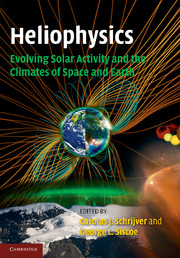Book contents
- Frontmatter
- Contents
- Preface
- 1 Interconnectedness in heliophysics
- 2 Long-term evolution of magnetic activity of Sun-like stars
- 3 Formation and early evolution of stars and protoplanetary disks
- 4 Planetary habitability on astronomical time scales
- 5 Solar internal flows and dynamo action
- 6 Modeling solar and stellar dynamos
- 7 Planetary fields and dynamos
- 8 The structure and evolution of the three-dimensional solar wind
- 9 The heliosphere and cosmic rays
- 10 Solar spectral irradiance: measurements and models
- 11 Astrophysical influences on planetary climate systems
- 12 Assessing the Sun–climate relationship in paleoclimate records
- 13 Terrestrial ionospheres
- 14 Long-term evolution of the geospace climate
- 15 Waves and transport processes in atmospheres and oceans
- 16 Solar variability, climate, and atmospheric photochemistry
- Appendix I Authors and editors
- List of illustrations
- List of tables
- References
- Index
- Plates
1 - Interconnectedness in heliophysics
Published online by Cambridge University Press: 05 April 2013
- Frontmatter
- Contents
- Preface
- 1 Interconnectedness in heliophysics
- 2 Long-term evolution of magnetic activity of Sun-like stars
- 3 Formation and early evolution of stars and protoplanetary disks
- 4 Planetary habitability on astronomical time scales
- 5 Solar internal flows and dynamo action
- 6 Modeling solar and stellar dynamos
- 7 Planetary fields and dynamos
- 8 The structure and evolution of the three-dimensional solar wind
- 9 The heliosphere and cosmic rays
- 10 Solar spectral irradiance: measurements and models
- 11 Astrophysical influences on planetary climate systems
- 12 Assessing the Sun–climate relationship in paleoclimate records
- 13 Terrestrial ionospheres
- 14 Long-term evolution of the geospace climate
- 15 Waves and transport processes in atmospheres and oceans
- 16 Solar variability, climate, and atmospheric photochemistry
- Appendix I Authors and editors
- List of illustrations
- List of tables
- References
- Index
- Plates
Summary
Introduction
The volumes on heliophysics, of which this is the third, emphasize universal processes for which some basic physical phenomenon manifests itself in a variety of circumstances throughout the local cosmos and beyond. The topics range from the variability of the star next to which we live to the distant interstellar medium, via planetary environments including, in particular, geospace in which a magnetic field and atmosphere shield us from most of the dangerous consequences of solar variability – taking us from solar flares, coronal mass ejections, and their associated energetic particles, via the dynamic interplanetary medium, to magnetospheric, ionospheric, and tropospheric consequences. This volume in particular emphasizes interconnectedness, which manifests itself in three different guises that appear, often implicitly, throughout the text.
First, there is the interconnectedness by the universal processes themselves: magnetohydrodynamics, radiative transfer, networks of chemical reactions, magnetic-field dynamics and topology, particle acceleration, shocks, turbulence, etc., pervade all three volumes. Second, we see the interconnectedness in the very evolution of the solar system, from the formation of the central star and its orbiting planets, to the impact of the star on planetary habitability, and the eventual demise of the solar system as we know it (Fig. 1.1). Third, there are many connections between a variety of research disciplines, each of which is advanced by what is learned from other disciplines, thus providing mutual support in their quest for deeper understanding.
- Type
- Chapter
- Information
- Publisher: Cambridge University PressPrint publication year: 2010



